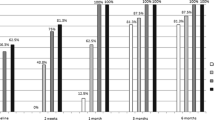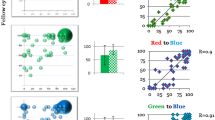Abstract
Purpose
To report dynamic changes in the retinal ganglion cell layer (GCL) and visual function in acute and chronic optic neuritis (ON).
Methods
Sixteen eyes (15 patients) with acute ON were followed for 3.5 to 31 months (average, 10.2). The best-corrected visual acuity (BCVA) and thickness of the GCL plus the inner plexiform layer (GCL+IPL) were measured 4 to 13 times between baseline and the final visit using the ganglion cell analysis software in the Cirrus HD-OCT [high-definition optical coherence tomography] instrument. Goldmann perimetry was performed at baseline and at the final visit.
Results
The thickness of the GCL+IPL at baseline was within normal limits in the affected (80.4 ± 4.9 microns) and unaffected fellow eyes (80.5 ± 5.0 microns). Rapid thinning to 69 ± 7.3 microns occurred during month 1 in the affected eyes, slowing during month 2, and then reaching a minimum level (63.6 ± 8.7 microns). In contrast, BCVA was lowest (mean ± standard deviation logarithm of the minimum angle of resolution, −1.29 ± 0.96) in 11 eyes at baseline, increased markedly to −0.15 ± 0.37 during month 1, and reached a maximum level (−0.18 ± 0.19) during month 2 and (−0.02 ± 0.23) at the final visit. The BCVA in the other five eyes fluctuated during month 1, increased markedly during month 2, and then reached a maximum plateau (−0.07 ± 0.20). The patterns of visual field defects at baseline were varied, and were determinants of BCVA. The visual field largely recovered in 11 eyes, but small central scotomas in four eyes and an enlarged blind spot in one eye remained at the final visit. Eyes with the least GCL+IPL thinning at month 1 or 2 had the least depression in the final deviation map.
Conclusions
In acute ON, the progression toward irreversible ganglion cell loss occurs rapidly during months 1 and 2. In contrast, visual function recovers rapidly during the same period. Remodeling of the neural network may occur between the photoreceptors and the reduced numbers of ganglion cells during the first months of ON. The small number of residual ganglion cells appears to compensate for the initial visual dysfunction.



Similar content being viewed by others
References
Beck RW, Cleary PA, Anderson MM Jr et al (1992) A randomized, controlled trial of corticosteroids in the treatment of acute optic neuritis. The Optic Neuritis Study Group. N Engl J Med 326(9):581–8
Optic Neuritis Study Group (1997) The 5-year risk of MS after optic neuritis. Experience of the optic neuritis treatment trial. Neurology 49(5):1404–13
Optic Neuritis Study Group (2008) Multiple sclerosis risk after optic neuritis: final optic neuritis treatment trial follow-up. Arch Neurol 65(6):727–32
Costello F F, Coupland S, Hodge W et al (2006) Quantifying axonal loss after optic neuritis with optical coherence tomography. Ann Neurol 59(6):963–9
Fisher JB, Jacobs DA, Markowitz CE et al (2006) Relation of visual function to retinal nerve fiber layer thickness in multiple sclerosis. Ophthalmology 113(2):324–32
Pueyo V, Martin J, Fernandez J et al (2008) Axonal loss in the retinal nerve fiber layer in patients with multiple sclerosis. Mult Scler 14(5):609–14
Burkholder BM, Osborne B, Loguidice MJ et al (2009) Macular volume determined by optical coherence tomography as a measure of neuronal loss in multiple sclerosis. Arch Neurol 66(11):1366–72
Tan O, Chopra V, Lu AT et al (2009) Detection of macular ganglion cell loss in glaucoma by Fourier-domain optical coherence tomography. Ophthalmology 116(12):2305–14.e1-2
Mwanza JC, Oakley JD, Budenz DL et al (2011) Macular ganglion cell-inner plexiform layer: automated detection and thickness reproducibility with spectral domain-optical coherence tomography in glaucoma. Invest Ophthalmol Vis Sci 52(11):8323–9
Syc SB, Saidha S, Newsome SD et al (2012) Optical coherence tomography segmentation reveals ganglion cell layer pathology after optic neuritis. Brain 135(Pt 2):521–33
Walter SD, Ishikawa H, Galetta KM et al (2012) Ganglion cell loss in relation to visual disability in multiple sclerosis. Ophthalmology 119(6):1250–712
Garcia-Martin E, Polo V, Larrosa JM et al (2014) Retinal layer segmentation in patients with multiple sclerosis using spectral domain optical coherence tomography. Ophthalmology 121(2):573–913
González-López JJ, Rebolleda G, Leal M et al (2014) Comparative diagnostic accuracy of ganglion cell-inner plexiform and retinal nerve fiber layer thickness measures by Cirrus and Spectralis optical coherence tomography in relapsing-remitting multiple sclerosis. Biomed Res Int 2014:128517
Rebolleda G, de Dompablo E, Muñoz-Negrete FJ (2015) Ganglion cell layer analysis unmasks axonal loss in anterior optic neuritis. J Neuroophthalmol 35(2):165–715
Huang-Link YM, Al-Hawasi A, Lindehammar H (2015) Acute optic neuritis: retinal ganglion cell loss precedes retinal nerve fiber thinning. Neurol Sci 36(4):617–20
Kupersmith MJ, Garvin MK, Wang JK et al (2015) Retinal ganglion cell layer thinning within one month of presentation for optic neuritis. Mult Scler 22(5):641–8
Shindler KS, Ventura E, Dutt M, Rostami A (2008) Inflammatory demyelination induces axonal injury and retinal ganglion cell apoptosis in experimental optic neuritis. Exp Eye Res 87(3):208–13
Mwanza JC, Budenz DL, Godfrey DG et al (2014) Diagnostic performance of optical coherence tomography ganglion cell--inner plexiform layer thickness measurements in early glaucoma. Ophthalmology 121(4):849–54
Author information
Authors and Affiliations
Corresponding author
Ethics declarations
Funding
No funding was received for this research.
Conflict of interest
All authors certify that they have no affiliations with or involvement in any organization or entity with any financial interest (such as honoraria; educational grants; participation in speakers’ bureaus; membership, employment, consultancies, stock ownership, or other equity interest; and expert testimony or patent-licensing arrangements) or non-financial interest (such as personal or professional relationships, affiliations, knowledge, or beliefs) in the subject matter or materials discussed in this manuscript.
Informed consent
For this type of study, formal consent is not required.
Rights and permissions
About this article
Cite this article
Fukuchi, M., Kishi, S., Li, D. et al. Acute ganglion cell loss during rapid visual recovery in optic neuritis. Graefes Arch Clin Exp Ophthalmol 254, 2355–2360 (2016). https://doi.org/10.1007/s00417-016-3408-9
Received:
Revised:
Accepted:
Published:
Issue Date:
DOI: https://doi.org/10.1007/s00417-016-3408-9




